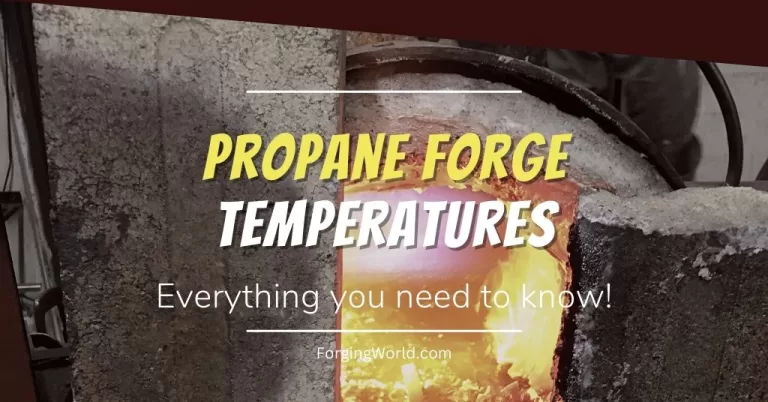Forging hardened steel can be a daunting task, but fear not, my fellow blacksmiths and knife makers!
If you’re new to the world of forging, you may be wondering what it takes to work with this type of steel.
Well, you’re in luck! In this article, I will share with you everything you need to know about forging hardened steel, from choosing the right tools to maintaining the right temperature.
What is Hardened Steel?
Before we jump into the process of forging hardened steel, let’s first define what it is. Hardened steel is basically steel that’s been “toughened up” by heating and cooling it rapidly.
Hardened steel can be more challenging to work with than mild or even medium steel, but you should take the time and effort to learn how to forge with it.
Can You Forge Already Hardened Steel?
The short answer is yes, you can forge already-hardened steel. But be warned, the process of forging hardened steel is much more complicated than regular forging and will require specialized tools and techniques.
So, if you’re just starting out, you might want to work on some regular steel first before moving on to the hard stuff.
What Tools Do You Need for Forging Hardened Steel?
Unlike forging regular steel, which can be done with just a hammer and anvil, forging hardened steel requires the use of specialized tools.
Here are some of the most important ones:
An anvil: You’re going to need a large, heavy piece of metal to shape and bend the steel during the forging process. Look for an anvil that’s made of high-quality steel and has a large surface area. Trust me, this is one tool you don’t want to skimp on.
A forge: You’ll need a forge to heat the steel to the right temperature for forging. There are different types of forges available, including gas forges and coal forges. Choose one that fits your needs and budget, and make sure it can get hot enough to make the steel malleable enough for forging.
Tongs: You’ll need a pair of long and sturdy tongs to hold the steel in place while you’re working on it. Look for tongs that are long enough to keep the heat away from your hands while still allowing you to get a good grip on the steel. Make sure they’re made of high-quality materials that won’t rust or break easily. It’s also helpful to have several sizes of tongs so that you can adjust them to fit the size of the steel you’re working with.
Preparing Hardened Steel to be Forged
Before you can start forging hardened steel, you’ll need to prepare it by heating it up. This is usually done in a gas forge, which must reach high enough temperatures to make the steel malleable enough for forging.
The temperature of the steel should usually be between 1,200 and 2,400 degrees Fahrenheit. You can monitor the temperature using several methods, I personally use a pyrometer to monitor the temperature accurately.
Once you’ve heated up the steel, you can use tongs to move it onto an anvil for forging. Make sure that the steel is evenly heated on all sides before beginning work.
Forging Hardened Steel
Now that you have your tools and steel prepared, it’s time to start forging!
When working with hardened steel, it’s important to remember that you’ll be dealing with high temperatures and forces. Make sure to wear proper safety equipment such as heat-resistant gloves and eye protection.
When it comes to the actual forging process, a hammer is usually used in combination with an anvil. Keep your hammer strokes steady, consistent, and light to achieve the desired shape.
If you’re making a knife or other small tools, you may also want to use a hammer with a peen.
It can take several attempts and lots of practice to get the perfect result when forging hardened steel. Don’t be discouraged if your first attempts don’t turn out as expected—keep practicing and refining your technique until you get it right.
Maintaining the Right Temperature
As I mentioned earlier, it’s important to maintain the proper temperature when forging hardened steel. If the steel gets too hot or too cold, it can become brittle and difficult to work with.
To ensure the steel maintains the right temperature, it’s important to use a furnace or forge that is capable of reaching and maintaining high temperatures. Additionally, you may want to use insulation materials like ceramic fiber blankets or fire bricks to help maintain the desired temperature.
You’ll also want to make sure that you’re using the proper cooling methods to ensure that the steel maintains its hardness and strength. Quenching is generally used to get rid of excess heat and improve the steel’s properties.
Conclusion
Forging hardened steel can be a challenging but rewarding process. By following these tips and using the right tools, you can create high-quality pieces that will stand the test of time.
Remember to always prioritize safety and take your time when working with this type of steel. With practice and patience, you can develop the skills needed to work with hardened steel and create beautiful, durable pieces that will last for years to come.
As a seasoned blacksmith and knife maker, I know firsthand the joys and challenges of working with hardened steel.
By sharing my experience and knowledge with you, I hope to help you achieve your own forging goals and create pieces that you can be proud of.
So, get out there, experiment, and have fun!



